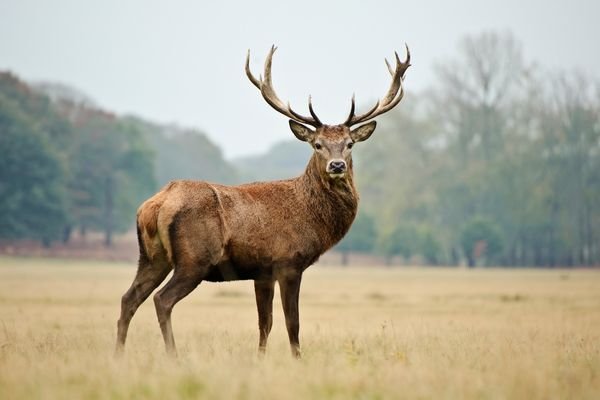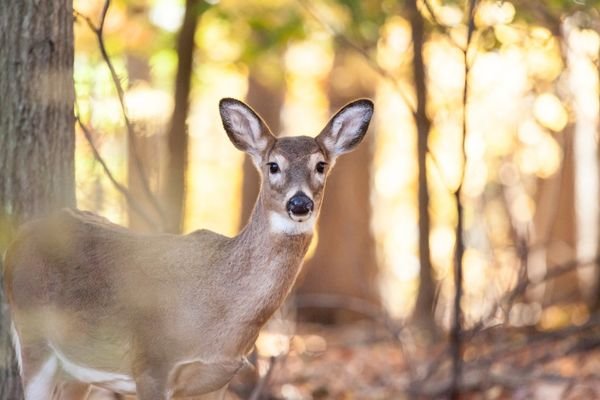It’s hard to tell the difference between buck track and doe track.
In this article, I’ll show you how to read them.
If you want to learn the deer habit and identify a buck or doe, keep reading:
Buck’s Track:

For most hoof-shaped species of deer, the front hooves are proportionally larger than those on the back legs and this is true for all mature bucks.
Of course, this is not the case with younger immature ones.
There are general sizes of tracks for mature bucks, for example, in North America, a mature whitetail’s track is between 2 ¾” and 3½” in length.
The width of the mature buck’s track will be between 3” and 4”; however, this will vary according to if the track was made in hard or soft ground.

On the other hand:
Bucks across all deer species are larger-bodied and taller than their female counterparts.
A taller animal with a broader chest will have a longer stride and a wider gap between the tracks on the left and the right.
A mature whitetail buck will have a stride length of just under 3-feet while walking and feeding. The stride would be longer if it were running or galloping and will make a deeper impression.
The splaying of the front hoof may be evident in the track of a large buck due to the weight of their front quarters, but this is not a set rule and will vary under different conditions.
Doe’s Track:

Female deer species tend to be lighter on the front with, a slender neck, smaller shoulders and lack of antlers which is the opposite towards the back end which is wider and heavier due to the birth canal.
With this, a doe’s hind tracks will make a deeper impression in softer ground that the front track.
Adult doe tracks measure anywhere from 1.5” to 3“ in length on the front with a width of 0.8” to 2”. The hind track’s length ranges from 1.25” to 2.5” and a width of 0.75” to 3”.
The ranges in size are all dependent on the ground condition of where the track was found.

More than that:
Apart from size, an obvious tell-tale sign that the track belongs to a doe is the presence of smaller tracks from a fawn that may be following in close behind the doe.
This will be a sign to look out for at specific times of the year.
Not commonly mentioned when trying to identify a doe’s track is the presence of urine.
Under dry conditions the presence of a urine patch slightly behind and in the middle of the hind tracks is an indication of a doe track.
Buck Track vs Doe Track – How To Tell A Buck From A Doe?
To accurately distinguish whether a set of tracks belongs to a buck or a doe, the hunter needs first to consider the following factors:
- Age of the tracks
- The condition of the ground; muddy, snow, dry, leaf litter
- Time of year
- Is there a full set of tracks (all four hooves) to determine stride length and shoulder width?
- Quality of the track, clear and obvious or just a partial track
Assessing these factors will lay the basis to use logic and the facts of doe and buck tracks, to determine which sex they belong to.
Here’s how:
Step 1: establish the size of the track
This is important because young bucks have tracks similar in size to that of mature does.
The best way to determine the size is by measuring them on ground that is firm enough for the track to be clearly visible without it sinking deep into the ground.
If the ground is soft and muddy, it may be necessary to follow the tracks until they are pressed into the ground which is slightly firmer giving a clear indication of the actual size.
Because tracks found in soft, muddy ground or deep snow can often make the track seem larger it can be assumed the track size is accentuated by ¾”.
Step 2: Access stride length and width
Once the size of the track has been established, stride length and width between the right and left tracks can be assessed.
The length will vary depending on whether the animal was running or not. An obvious sign of the animal running would be the splayed hooves and indentation of the dew claws.
Bucks will have a longer stride and will be a greater distance between the right and left hooves, than a doe.
It should also be concluded whether the animal was running or walking slowly.
Step 3: Placement of the back hooves
The placement of the back hooves is another sign to consider.
Bucks being slightly narrow in the hips means they will place their back hoof to the rear of where the front hoof was placed.
Whereas a doe’s rear hoof will typically land directly on top of or just off the front track.
This is by no means a set rule and will be difficult to see in mud and snow.
Step 4: Identify gender
The final step in determining the sex, is to assess external clues aside the actual tracks.
Time of year plays a big role in providing vital information to determine whether the tracks belong to a doe or a buck.
Small tracks mixed in with larger tracks during spring or summer are most likely female groups with fawns.
Large solitary tracks during fall would be mature males.
These large solitary tracks coupled with signs of antler scraping on trees and bushes are a sure sign of a male deer and they will be especially prevalent during the rut.
Conclusion:
In order to correctly ascertain whether the tracks belong to a buck or doe, you cannot simply use one set of tracks to make a final decision, as many other factors need to be taken into consideration, such as terrain, age of track, condition of ground and time of year.
Over time and with experience of seeing various sizes and types of tracks out in the field, a hunter could very well develop the skills to determine a buck’s track vs a doe’s track.
